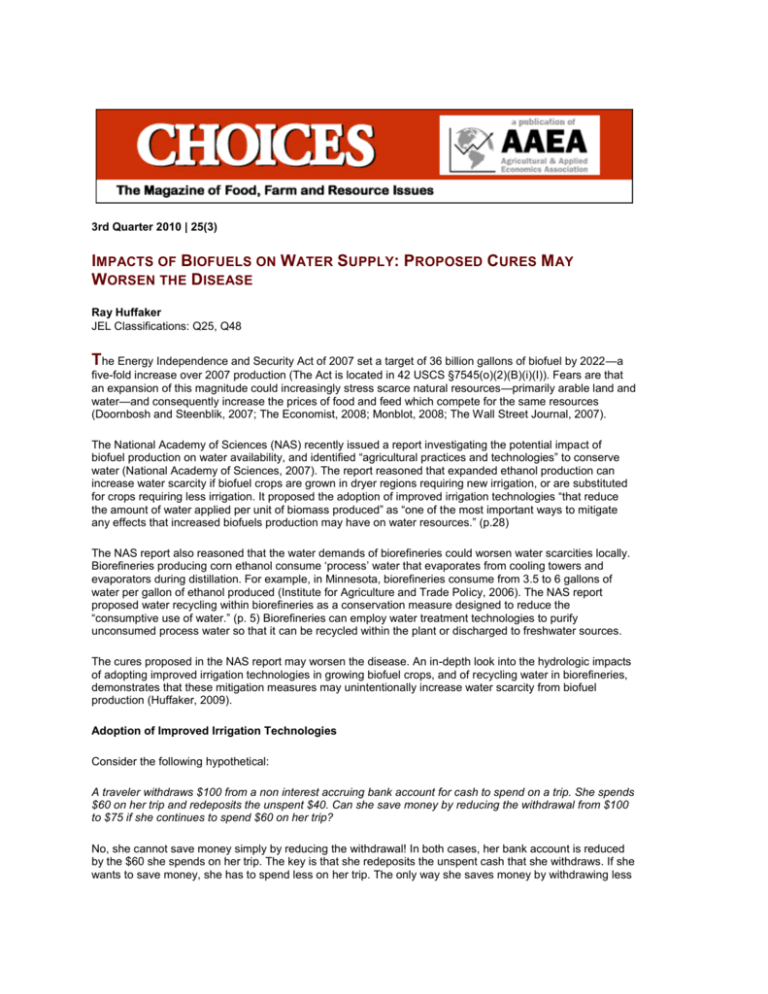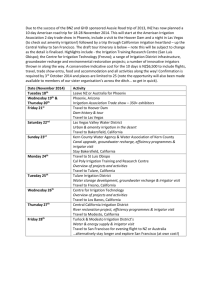
3rd Quarter 2010 | 25(3)
IMPACTS OF BIOFUELS ON WATER SUPPLY: PROPOSED CURES M AY
WORSEN THE DISEASE
Ray Huffaker
JEL Classifications: Q25, Q48
The Energy Independence and Security Act of 2007 set a target of 36 billion gallons of biofuel by 2022—a
five-fold increase over 2007 production (The Act is located in 42 USCS §7545(o)(2)(B)(i)(I)). Fears are that
an expansion of this magnitude could increasingly stress scarce natural resources—primarily arable land and
water—and consequently increase the prices of food and feed which compete for the same resources
(Doornbosh and Steenblik, 2007; The Economist, 2008; Monblot, 2008; The Wall Street Journal, 2007).
The National Academy of Sciences (NAS) recently issued a report investigating the potential impact of
biofuel production on water availability, and identified “agricultural practices and technologies” to conserve
water (National Academy of Sciences, 2007). The report reasoned that expanded ethanol production can
increase water scarcity if biofuel crops are grown in dryer regions requiring new irrigation, or are substituted
for crops requiring less irrigation. It proposed the adoption of improved irrigation technologies “that reduce
the amount of water applied per unit of biomass produced” as “one of the most important ways to mitigate
any effects that increased biofuels production may have on water resources.” (p.28)
The NAS report also reasoned that the water demands of biorefineries could worsen water scarcities locally.
Biorefineries producing corn ethanol consume ‘process’ water that evaporates from cooling towers and
evaporators during distillation. For example, in Minnesota, biorefineries consume from 3.5 to 6 gallons of
water per gallon of ethanol produced (Institute for Agriculture and Trade Policy, 2006). The NAS report
proposed water recycling within biorefineries as a conservation measure designed to reduce the
“consumptive use of water.” (p. 5) Biorefineries can employ water treatment technologies to purify
unconsumed process water so that it can be recycled within the plant or discharged to freshwater sources.
The cures proposed in the NAS report may worsen the disease. An in-depth look into the hydrologic impacts
of adopting improved irrigation technologies in growing biofuel crops, and of recycling water in biorefineries,
demonstrates that these mitigation measures may unintentionally increase water scarcity from biofuel
production (Huffaker, 2009).
Adoption of Improved Irrigation Technologies
Consider the following hypothetical:
A traveler withdraws $100 from a non interest accruing bank account for cash to spend on a trip. She spends
$60 on her trip and redeposits the unspent $40. Can she save money by reducing the withdrawal from $100
to $75 if she continues to spend $60 on her trip?
No, she cannot save money simply by reducing the withdrawal! In both cases, her bank account is reduced
by the $60 she spends on her trip. The key is that she redeposits the unspent cash that she withdraws. If she
wants to save money, she has to spend less on her trip. The only way she saves money by withdrawing less
cash is if she always spends all of the cash on her trip. In such a case, she would save $25 = $100 -$75.
This hypothetical may seem overly simple to shed much light on the complex issue of whether adoption of
improved irrigation technologies conserves water. Not so—the same principles apply! Surprisingly, water
policy worldwide falls prey to the misconception that savings can always be measured by reductions in
withdrawals.
Consider the above hypothetical recast in the context of irrigated agriculture:
An irrigator has water rights to withdraw 100 units of water from a river to grow a crop over a growing season.
The crop consumes 60 units of the withdrawn water…
The rate at which crops consume water depends on crop size and atmospheric evaporative demand (ET)—
the sum of evaporation from open-water or moist-soil surfaces and transpiration from plants. On-farm
irrigation efficiency is defined as the ratio of ET to applied water. If an irrigation technology is 100% efficient,
then every unit of applied water satisfies the crop’s ET demand. However, in practice, only a fraction of
applied water is converted to ET. For example, graded furrow surface irrigation is characterized by
efficiencies ranging from 50% to 80%, depending on field characteristics and how well an irrigator regulates
set times and stream sizes. The irrigation technology in this hypothetical is 60% efficient since the 100 units
of withdrawn water are converted to 60 units of ET.
…the unconsumed 40 units of water return to the river system in a usable form…
One reason for an irrigation technology to be less than 100% efficient is that it does not apply water uniformly
over the field. Some parts of the field are over-irrigated—plants are flooded, and others are under-irrigated—
plants are water stressed. Water in excess of crop ET requirements can recharge the surrounding hydrologic
system via surface runoff to a river or deep percolation through soil into an aquifer. Both types of recharge
constitute ‘irrigation return flow’. In this hypothetical, all 40 units of unconsumed water recharge the river
system.
…Can the irrigator conserve water by increasing on-farm irrigation efficiency from 60% to 80%, if crops
continue to demand 60 units of ET?
No, the irrigator does not save water simply by increasing irrigation efficiency! Although the water withdrawal
required for 60 units of ET is reduced from 100 units to 75 (= 60/0.8) units, the overall water supply continues
to be reduced by the full 60 units of ET. The key is that water not converted to ET—irrigation return flow—
recharges the water supply in the broader hydrologic system. Conservation requires that the irrigator adopt
technologies reducing the ET demand of crops. ET demand can be reduced, for example, by adopting
irrigation technologies that reduce evaporation from open-water or moist soil surfaces, by irrigating fewer
acres, by switching to crops requiring less water, or by irrigating crops at a deficit. When irrigation return flow
is an insignificant component of water supply, then reductions in water withdrawals constitute conserved
water.
The irrigator conserves water by reducing withdrawals only if none of the water returns to the hydrologic
system in a usable form. In such a case, she would save 25 = 100 – 75 units. This is the hydrologic world
implicitly assumed by the NAS report when it reasons that improved irrigation technologies “that reduce the
amount of water applied per unit of biomass produced” would “mitigate any effects that increased biofuels
production may have on water resources” (p. 28). The implication that irrigation return flow is negligible
where biofuel crops are grown is unjustified. For example, irrigation return flow is estimated to constitute
almost half of the water diverted in the Western United States (Pulver, 1988). Western water laws protect
appropriators from changes in upstream water uses that would reduce return flow constituting part of their
water supply.
More importantly, policy that ignores the role of irrigation return flow in touting improved irrigation efficiency
as a fail-safe conservation measure can be counterproductive. Such policy can give the illusion of water
conservation, and worse yet, mask unintentional reductions in water supplies if more efficient water
application increases crop demand for ET (Allen, Willardson, and Frederiksen 1997). The ‘cure’ worsens the
disease! For example, a policy of increased on-farm irrigation efficiency in the North China Plain reduced
pumping rates by 50%—giving the illusion of conservation, but failed to stem the rapid decline of
groundwater due to increases in ET—thereby reducing deep percolation of unconsumed irrigation water
recharging the aquifer. The study generating this result recommended that China protect the aquifer by
reducing irrigated acreage (Kendy et al., 2003).
Water Recycling in Biorefineries
Let’s revisit a modified version of the original hypothetical:
The traveler withdraws $100 from a noninterest accruing bank account for cash to spend on two trips. She
spends $60 on the first trip, $20 on the second trip, and redeposits the unspent $20. Has she saved money
by ‘recycling’ the withdrawn cash through another trip?
The traveler has not saved money. She has done the opposite since her bank account is reduced by the
additional $20 spent on the second trip.
Similarly, each time process water is recycled through the biorefinery, evaporative losses increase, return
flow decreases, and the overall water supply is reduced to the detriment of other users. The NAS report
misses this hydrologic causal chain by mistakenly assuming that recycling reduces the consumptive use of
water. Conservation policies should promote the adoption of new processing technologies that reduce
evaporative losses.
There are problems with generally relying on improved on-farm irrigation efficiency in growing biofuel crops
and recycling of process water in biorefineries as water conservation measures in biofuels production. This
does not imply that these measures can not convey substantial benefits in other applications. For example,
both measures can mitigate the impacts of biofuels production on water quality by reducing the throughput of
water into farm and biorefinery production. Moreover, improved on-farm irrigation efficiency can convey
substantial benefits at the field level including improved salinity control, reduced water-logging, reduced soil
erosion, and reduced leaching of fertilizers and other chemicals. Policymakers must understand the
hydrologic implications of these measures so that they are well applied to achieve desired outcomes.
For More Information
Allen, R., Willardson, L., and Frederiksen, H. (1997). Water use definitions and their use for assessing the
impacts of water conservation. Proceedings of the ICID Workshop on Sustainable Irrigation in Areas of Water
Scarcity and Drought.
Doornbosch, R., and Steenblik, R. (2007). Biofuels: Is the cure worse than the disease? Round Table on
Sustainable Development, OECD.
New reasons to be suspicious of ethanol. (2008, February 28). The Economist, p. 28.
Huffaker, R. (2009). Protecting water resources in biofuels production. Water Policy, 12, 129-34.
Institute for Agriculture and Trade Policy. (2006). Water use by ethanol plants. Minneapolis, Minn.
Kendy, E., Molden, A., Steenhuis, T., and Liu, C. (2003). Policies drain the North China Plain: agricultural
policy and groundwater depletion in Luancheng County, 1949-2000. Research Report 71, International Water
Management Institute, Colombo, Sri Lanka.
Monblot, G. (2008). An agricultural crime against humanity. Conservation Magazine, 9.
National Academy of Sciences. (2007). Water implications of biofuels production in the United States.
National Academies Press.
Pulver, R. (1988). Liability rules as a solution to the problem of waste in western water law: An economic
analysis. California Law Review, 76, 671-726.
Ethanol backlash. (2007, November 12). The Wall Street Journal, p. A-16.
Ray Huffaker (rhuffaker@ufl.edu) is Professor and Chair, Food and Resource Economics Department,
University of Florida, Gainesville, Florida
© 1999-2010 Choices. All rights reserved. Articles may be reproduced or electronically distributed as long as
attribution to Choices and the Agricultural & Applied Economics Association is maintained.










